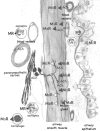Muscarinic receptor antagonists, from folklore to pharmacology; finding drugs that actually work in asthma and COPD
- PMID: 21198547
- PMCID: PMC3085867
- DOI: 10.1111/j.1476-5381.2010.01190.x
Muscarinic receptor antagonists, from folklore to pharmacology; finding drugs that actually work in asthma and COPD
Abstract
In the lungs, parasympathetic nerves provide the dominant control of airway smooth muscle with release of acetylcholine onto M3 muscarinic receptors. Treatment of airway disease with anticholinergic drugs that block muscarinic receptors began over 2000 years ago. Pharmacologic data all indicated that antimuscarinic drugs should be highly effective in asthma but clinical results were mixed. Thus, with the discovery of effective β-adrenergic receptor agonists the use of muscarinic antagonists declined. Lack of effectiveness of muscarinic antagonists is due to a variety of factors including unwanted side effects (ranging from dry mouth to coma) and the discovery of additional muscarinic receptor subtypes in the lungs with sometimes competing effects. Perhaps the most important problem is ineffective dosing due to poorly understood differences between routes of administration and no effective way of testing whether antagonists block receptors stimulated physiologically by acetylcholine. Newer muscarinic receptor antagonists are being developed that address the problems of side effects and receptor selectivity that appear to be quite promising in the treatment of asthma and chronic obstructive pulmonary disease.
© 2011 The Authors. British Journal of Pharmacology © 2011 The British Pharmacological Society.
Figures


References
-
- ACC/AHA. 2005 American heart association guidelines for cardiopulmonary resuscitation and emergency cardiovascular care. Circulation. 2005;112(24) Suppl:IV1–203. - PubMed
-
- Acevedo M. Effect of acetyl choline on ion transport in sheep tracheal epithelium. Pflugers Arch. 1994;427:543–546. - PubMed
-
- Anthonisen NR, Connett JE, Kiley JP, Altose MD, Bailey WC, Buist AS, et al. Effects of smoking intervention and the use of an inhaled anticholinergic bronchodilator on the rate of decline of FEV1. The Lung Health Study. JAMA. 1994;272:1497–1505. - PubMed
-
- Aquilina AT, Hall WJ, Douglas RG, Jr, Utell MJ. Airway reactivity in subjects with viral upper respiratory tract infections: the effects of exercise and cold air. Am Rev Respir Dis. 1980;122:3–10. - PubMed
-
- Ayala LE, Ahmed T. Is there loss of protective muscarinic receptor mechanism in asthma? Chest. 1989;96:1285–1291. - PubMed
Publication types
MeSH terms
Substances
Grants and funding
LinkOut - more resources
Full Text Sources
Other Literature Sources

